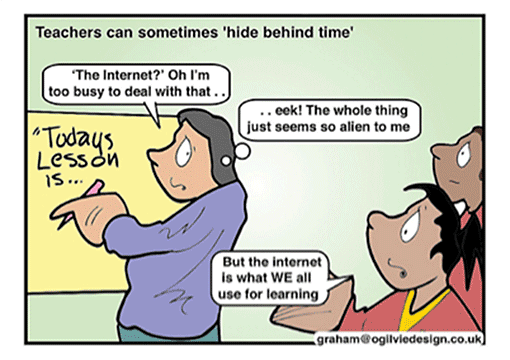The Role of the School/Teacher in DigCit
As the world relies increasingly on digital technologies, our students need guidance on how to be safe, savvy, and social while using it. Schools can play an integral part in teaching and learning to support students’ media literacy to be critical of what they access online. The use of technology can be both advantageous and detrimental to learning.
The advantages of technology to enhance learning are countless. The ability to share information with others, think critically and creatively, express oneself and create action to engage others are just some of the benefits of technology use. Schools and teachers can create a safe place to discover various applications of technology through guided practice and scenarios students may counter in their everyday life.

The article that Gerry shared with the class outlines the main competencies to support media literacy. I could immediately see how these could tie into the core curriculum. For instance, the “Action/Agency: the capacity to act and engage in citizenship through media, to become political agents in a democratic society” transfers to Health and Social Studies curriculum. Additionally, the article addresses the challenges of students being exposed to disinformation, propaganda and negative messages. This exposure, without the skills to differentiate between fake and real information can lead to further mendacity. One of the challenges highlighted in the article is how to “effectively consolidate the school and out-of-school media literacy practices”.
Gunpreesh shared the link to the Common Sense Education site with activities, videos and lesson plans for teaching digital citizenship. This site is an integral part of my major project. The format and ease of access to a multitude of resources has been so helpful in creating my own resource for teaching digital literacy to the primary grades.
During the COVID-19 pandemic, educators were asked to teach students online. Many educators had never used the technology required to teach online and the learning curve was immense. However, the benefits of this technology have proven to both be a positive and negative to student learning. It brought to light the accessibility of technology to the privileged and non-privileged. Another thing we learned about online learning was that some students excelled with a digital platform and independent study but many did not succeed with the lack of connection of in-person learning. As we entered back into schools, the gap in learning between those who had access to technology and those who did not, was evident. The need for teaching digital skills to create a foundation of knowledge using technology and how to act with these tools. Kelly presented an article that describes methods on implementing digital citizenship in the classroom. I really appreciated the list of reasons it may be difficult to implement digital citizenship in schools and some strategies on how to make it simpler to put into action. Durston’s article also described some ways to “weave digital citizenship into the school day and for parents to reinforce it at home”. I really liked the idea of having ‘after-lunch meetings’ to focus on a digital citizenship topic and then reinforce it in content instruction.
I believe Digital Citizenship could be a stand alone class to be offered to students to focus on technology and have dedicated time to work on media literacy skills. Equally important is to use media literacy education in all curriculum areas for research skills, explore ways to showcase learning and collaborate with others near or far.

My current school does not have specific digital citizenship classes taught. The primary classroom teachers only have 6 Ipads in their classrooms for students to use. The Ipads have specific educational applications loaded on them for students to use. The teachers take some time to show the students how to use the apps and briefly discuss safe use of the Ipads. The grade 4-8 classrooms have chromebooks in their classrooms, but not a full class set. (If they are able, teachers borrow chromebooks from other classrooms so each student in the classroom has access to technology for the lesson being taught.) The middle grade teachers instruct students on certain aspects of digital citizenship within core curriculum content, but I’m not sure of home much is within the context of their out-of-school lives. For many teachers, the thought of teaching digital citizenship is “another thing” to teach, but with careful strategic planning, it can be easily woven into daily work. The hope would be to have more carryover into their lives outside of school. Additionally, having parents and community members be involved with reinforcing positive digital citizenship would be ideal. When we are able to have parents and community members in our school, I would like to help promote digital citizenship information nights to show how we use technology in school and safe applications to use at home.
You have shared great points in your post, Brenda. Providing digital citizenship education to our students with a prescribed curriculum and a good amount of supplies is necessary. Children and teens need to develop critical thinking skills in order to get the best use out of digital technologies, basically giving them hands-on experience is imperative.
I really enjoy the comic you added to your post. It sums up teaching digital citizenship perfectly! Some teachers aren’t very tech-savvy and have been teaching a specific way for years. Other teachers just don’t know where to start or where to fit it into their school day. I believe that teachers need support from their school division on how to teach digital citizenship. Luckily, this class has really taught me what I am able to do, but not every teacher will take a class like this. I think with the knowledge I gain with this course, I’ll be able to work it into my day more and more.
I agree, Brenda, that many teachers view Digital Citizenship as ‘just one more thing to teach.’ I am kind of there, myself. At this point in the year, I am trying to cover all of my other curriculum, and while this class is making me ponder how I can weave in some Dig Cit, it is, indeed, ‘one more thing’ for me to try and squeeze in. I think this is more of a system problem, with the curriculums already being quite full, than a teacher attitude problem. Teachers want to teach their students meaningful skills to help them in their real lives; perhaps if the quantity of curriculum content was lessened (or made more flexible), teachers would feel they have more time to attend to some of these other topics?
We can always use the hidden curriculum to get the students the good stuff!! Obviously time and knowledge are quintessential but there are ways we can add it it to what we are currently doing. Don’t get me wrong, I am all for a separate core curriculum for dig cit but the key question is ‘what would have to go’?
There seem to be two common things talked about in most people’s blog posts this week: 1) Individual schools aren’t really doing too much as a whole, and 2) many teachers are feeling as if teaching DC is just one more thing on their already full plates.
I wonder how we can change the narrative. How do teachers have more of a voice for policy makers and curriculum writers? How do we get our schools, school divisions, and the ministry on board for teaching a concept that is so relevant in today’s world, and important to learn? Is there something more that we can be doing to raise attention towards this? I know Alec said that the university can’t implement a mandatory course until the government/ministry approves it. So how do we make that happen? I know… there seem to be a lot more questions than answers, or people that have answers too.
Such an amazing article Brenda… I agree that technology is helpful to enhance in countless ways. But yes, everything has its pros and cons. We, as educators are trying to indulge digital literacy in students but we need an adequate amount of gadgets as well… Moreover, sometimes we are so involved in our curriculum that we forget to skip teaching them about this topic. As you mentioned, I also agree that Digital Citizenship could be a stand-alone class.
Excellent work, Brenda! I agree – I would love to see parent information nights and that’s mostly because I am a parent! Wouldn’t it be neat if these info sessions were presented to parents by their children?! My major project is focused on a tenacious group of grade 8s who are just eating up the activities I am doing with them…I wonder if we could work on some of our public speaking skills and create digial citizenship presentations for the parents. Thanks for the inspiration!